Class 1 - Interfacing Elevator Controls with Fire Alarm and Sprinkler Systems + ERCES provisions
GENERAL INFORMATION
THERE WILL BE LIVE UNLIMITED Q & A SESSIONS AT THE END OF EACH TRAINING DAY
Notes: |
|
CONTINUED EDUCATION / ACCREDICATION
ICC Course No 19706
For information please click  HERE.
HERE.
Approved for 8 Hrs - 0.8 ICC-CEUs

CLASS DESCRIPTION
Chapter 30 (Elevators) of the 2024 IBC and 2025 CBC include significant changes related to elevators and sprinkler protection, gurney size, and hoistway smoke protections and hoistway ventilation which will be discussed and clarified.
The 2025 editions of NFPA -72 and NFPA-13 will be presented and discuss with major changes in NFPA 13 regarding sprinkler omissions and protection of hoistways and machine room and suspension means.
The latest 2022 editions of NFPA 1225 (ERCES) and ASME A17.1 (National elevator Code) will be presented and discussed.
Alterations projects for existing elevators with or without F.E.O (Firefighters Emergency Operations) will be discussed and clarified.
LEARNING OBJECTIVES/OUTCOMES
- After attending this class, participants should be able to understand and define the different type of elevators in low and high-rise buildings such as Hydraulic, Traction, Machine-Room-Less (MRL), Passenger, Freight, Service, Destination-Dispatch, and Limited-Use-Limited-Application Elevators (LULAs).
- Participants should be able to identify all building and life safety codes, NFPA 13, 72 and 1225 standards and ASME A17.1 elevator code, associated with elevator emergency operation and the cross references between these codes and standards.
- Understand basic Fire Emergency Operation (FEO) terms such as, Phase-I emergency recall operations and Phase -II in-car emergency operation, elevator power shunt trip, Fire Emergency Operation (FEO), dedicated function fire alarm system for elevator recall and supervisory, Designated and Alternate Recall Levels, Firefighters' Flashing Helmet, and other Fire-Elevator associated terms
- Understand the specific requirements of NFPA 13 (sprinkler code) and NFPA 72 (fire alarm and signaling code) for interfacing elevator controls with these systems. Understand and learn how to apply specific NFPA 72 Chapters 21 and 23 and NFPA 13 Chapter 8 and NFPA 1225 interface requirements to existing and new elevators both in buildings provided with "Building Fire Alarm Systems" and/or Sprinkler systems and those buildings without Fire Protection Systems.
- Understand specific California State elevator safety requirements such as CCR-Title 8 Elevator Safety Orders (ESO) for Group 2, 3 and 4 Existing and NEW elevators and IBC-2021/CBC-2022/2025 exempt locations of sprinklers in elevator associated spaces.
TARGET AUDIENCE
- Fire Alarm and Sprinkler Systems Personnel: Designers, Installers, Technicians, Service personnel, Vendors, Engineers.
- Authority Having Jurisdiction (AHJ) and Code Officials Personnel: Fire, Building, Elevator, Electrical, Mechanical Inspectors, Code Enforcers and Plans Reviewers.
- Elevator Personnel: Mechanics, Consultants, Engineers, Vendors, Inspectors.
- Building Personnel: Owners, Managers, Building Engineers, Property managers.
- Professionals: Architects, Mechanical, Electrical and Fire Protection Engineers.
- Fire Service Personnel: Firefighters, Fire Inspectors.
CLASS OUTLINE
TWO 4-Hours sessions via Live Zoom Training + Unlimited Q&A Session | |||||||||||||||
Session # 1, Thursday, December 11, 2025 (starts at 8:00 am PST) | |||||||||||||||
| |||||||||||||||
Total – 4 Hours session+++ Session # 2, Friday, December 12, 2025 (starts at 8:00 am PST) | |||||||||||||||
Total – 4 Hours session+++ |
KEYWORDS ASSOCIATED WITH THE CLASS
Traction Elevators, Hydraulic Elevators, Machine-Room-Less Elevators, Phase I Emergency Recall Operation, Phase II - In Car Emergency Operation, Designated Recall Floor, Alternate Recall Floor, Building Fire Alarm System, Dedicated Function Fire Alarm System, Elevator Hoistway, Elevator Pit, Elevator Shunt Trip Function, Radio Coverage, Critical Areas, Elevator Car Live Communications System
CLASS ASSOCIATED CODES AND STANDARDS
- NFPA 13 -2022 Edition and 2025 edition
- NFPA 72-2022 Edition and 2025 edition
- NFPA 1225-2022 Edition
- ASME A17-1 2022 Edition
- CA Title 8 - Elevator Safety Orders (ESO) - Chapter 4 - Sub-Chapter 6 - Group 4 Regulations Bases on ASME A17.1 - 2004, and NEW Group 5 Regulations Based on ASME A17.1-2019
- IBC 2024 Edition
- IFC 2024 Edition
- CBC 2025 Edition
- CFC 2025 Edition





